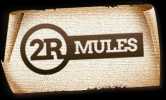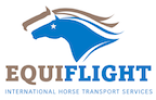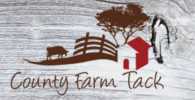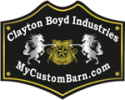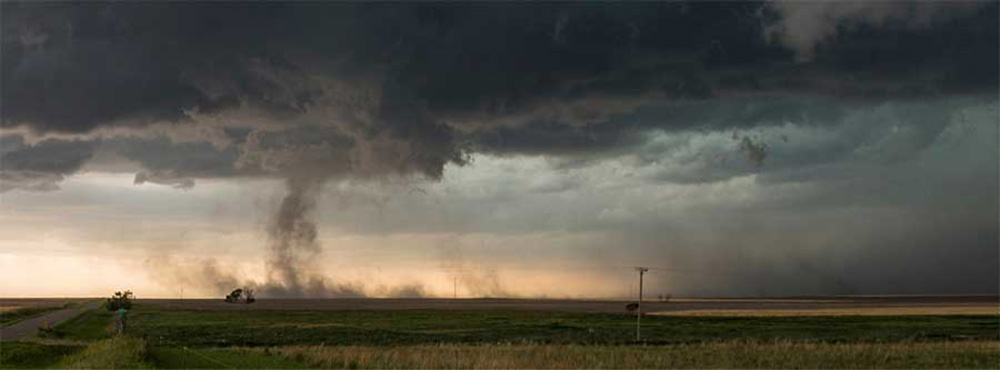
by Kelly Melvin, Graduate Research Assistant
Jennie Ivey, PhD, PAS, Assistant Professor and Extension Equine Specialist, Department of Animal Science, Univ. of Tennessee
In light of recent flooding, wildfires, and other natural disasters in the United States, there has been increased concern regarding how to prepare horse farms for various natural disaster situations. Being prepared before disasters occur is the best way to increase your animal’s chance of survival and safety.
Before a Disaster Hits
Do you have an updated yearly plan of action for emergency situations? Having a plan of action before a disaster hits can help reduce both human and animal stress, increase survival, and minimize damages. Always heed evacuation notices to keep you and your family safe.
Property Risk Assessment
Working knowledge of your property is important in understanding potential risks and developing a plan of action. Areas prone to flooding, wildfire, tornadoes, earthquakes and hurricanes can pose risks to both animals and humans. For example, if you live in a floodplain, consider building barns and homes on higher ground to decrease the chance of flooding. If you live in a location prone to wildfires, consider having a defensible area, which is an area void of objects such as leaves and trees that burn easily, around both your home and barn. Regardless of where you live, remove all hazardous fencing and consider options to reroute permanent and temporary fencing so horses can move to higher ground during flooding or to low lying areas in wind events.
Facility Options for Evacuations
An important part of disaster preparedness is having knowledge of facilities available or willing to accept horses and other livestock in the event of an evacuation. During mandatory or voluntary evacuations facilities can fill up quickly; thus, it is important to have multiple options. Have a list of local and long distance facilities that can accommodate you and your horses during a disaster. Some facility recommendations include show/fairgrounds and boarding facilities. Contact your state extension specialist for a list of potential facilities that are willing to accept evacuees. When contacting facilities, ask questions to determine requirements such as vaccine records, records of a negative coggins (EIA test), and available space. During times of flooding, food maps can help you to determine if evacuation routes will remain open. Lastly, print directions and alternate routes to each facility in case GPS access is limited.
Local Emergency Contacts
Established emergency contact information is important during times of natural disasters in order to quickly respond to hazardous situations. You should have current contact information for local law enforcement, fire department, disaster relief teams, large animal rescue teams, veterinarians, trailering services, poison control, and evacuation facilities all easily accessible. Getting to know your neighbors can be of great help as you may not be home during times of crisis. Neighbors and friends can also pool resources such as trailering, feed and water, or other emergency items in times of need.
Travel Requirements
When traveling with horses, proof of negative coggins, vaccine records and proof of ownership
are all required documents. For those traveling to another state, a health certificate performed by a licensed veterinarian within 30 days will be required as well. Keep copies of documents in a folder or binder that you can access during travel. In some statewide emergency situations, required paperwork to travel or cross state lines may be waived. Check with state government officials along with the destination state’s government before travel to determine travel requirements or extenuating circumstance exceptions.Provisions
During the year, it is best to have at least seven days’ worth of hay, clean water, and feed stored in areas that will not spoil by contaminated water or fires. The ability to store 12-20 gallons of water per horse per day is recommended. Storage can include clean plastic cans or containers, water troughs, or drums. Horses may refuse water that has been stored due to taste. You may choose to add commercially available equine electrolytes or other water favoring such as Gatorade to entice horses to drink. Always offer plain water as well. Lastly, when creating an emergency plan, try to find alternate sources of water and electricity in the event that usage or availability is limited.
Equine Identification
Having both permanent and temporary forms of identification on your horses is one of the best ways to help reunite lost horses with their owners in times of natural disasters. Reference both identification examples below.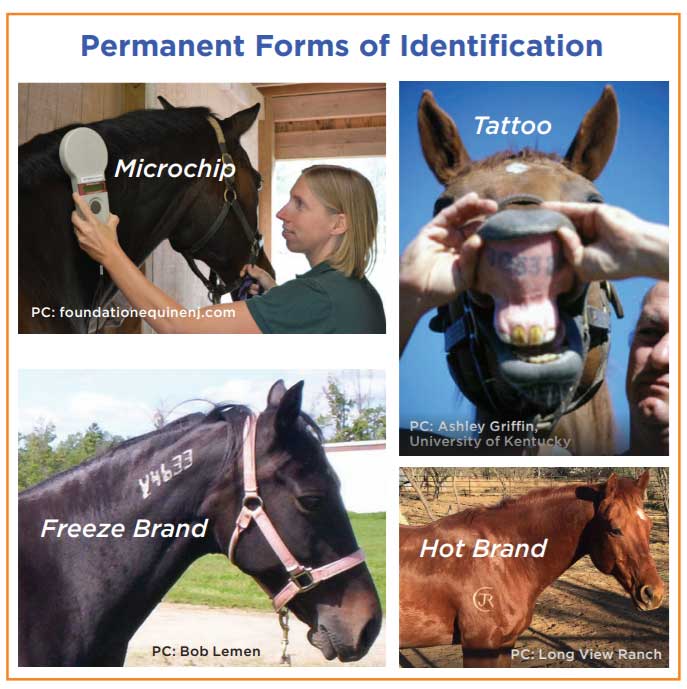
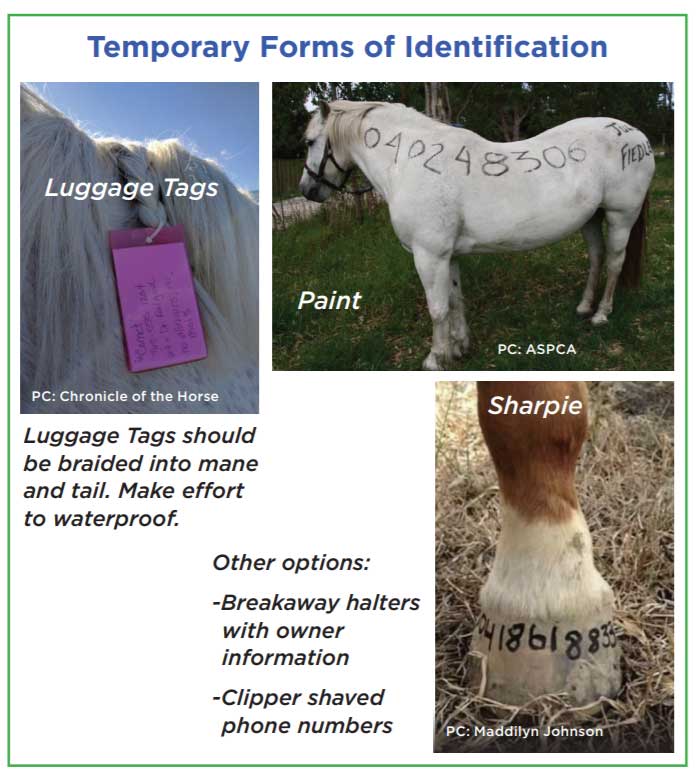
Safety and Communication Plan
It is best to educate your entire family about the emergency plan for your home and barn. If you have boarders or employees, include them in your plan. Identify specific safe places to convene on and of your property. Have a designated family contact outside of the state for family members to check in with and reunite. Make sure every person in the family has current information and that information is written down and distributed. In the event that you are not home during the disaster and an animal is injured, having a signed letter authorizing veterinary treatment is recommended.
Truck and Trailer Maintenance
Make sure your truck and trailer are properly maintained, suitable for hauling, and stored in an area where they can be easily accessed in emergency situations. Use the 10-point checklist in this publication to regularly monitor truck and trailer safety.
Furthermore, make sure your horse(s) are accustomed to loading into a trailer. For situations in which horses are without halters, not accustomed to handling or trailer loading, or foals, using panels to corral them can encourage loading onto the trailer. You can also use a rope around the neck to help lead horses onto the trailer. Lastly, for horses that may need more encouragement to load, a rope around their rump can help. If you do not have a trailer available, keep local contacts for times of emergencies
Ten-Point Truck and Trailer Inspection
Ask yourself these questions:
- Have you checked all of the tires for both the truck and trailer? Do tires have at least ¼ inch of tread left? Are the tires dry rotted? Is the tire pressure at the recommended psi? Always check the spare as well!
- When was the last time you checked the brakes, emergency breakaway cables, pin and control box, and all bearings to ensure proper working condition?
- Do all of the lights work? Is there any loose wiring?
- Have you checked the hitch for rust and improper welds? Are the safety chains and snaps in good condition?
- Is there any rust on the hitch, frame, etc.? If so, rust should be removed or repaired.
- Does the ramp work and is it in good condition?
- Have you inspected the floors and walls for rotting, stability issues, corrosion, etc?
- Are there any loose bolts, screws, nails, etc?
- Does the butt bar have any cracking?
- Do you have a jack and safety triangles? Is the jack lubricated?
Additional considerations should include fuel, a vehicle emergency kit, and an emergency roadside provider for hauling horses.
Emergency Kit
Have an emergency kit and first aid kit ready for both humans and animals. Recommendations for items to include can be found below:
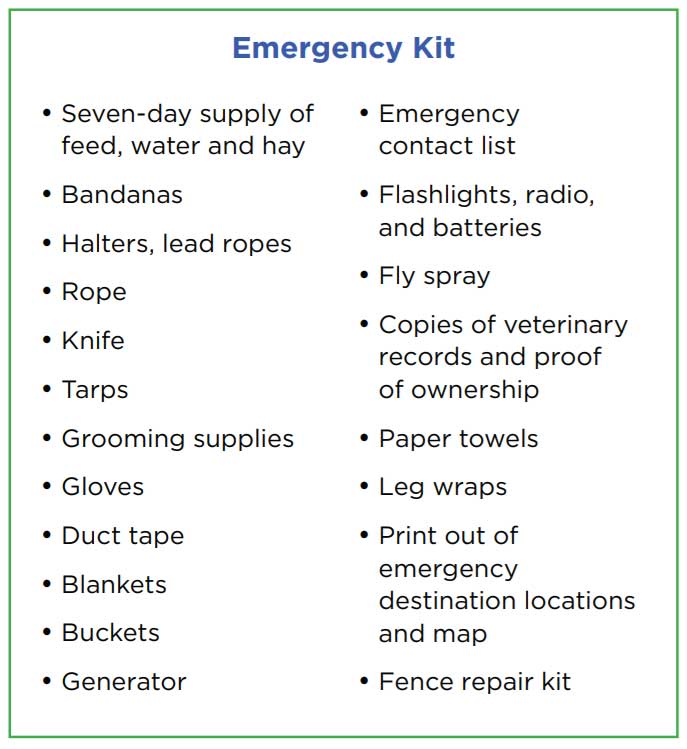
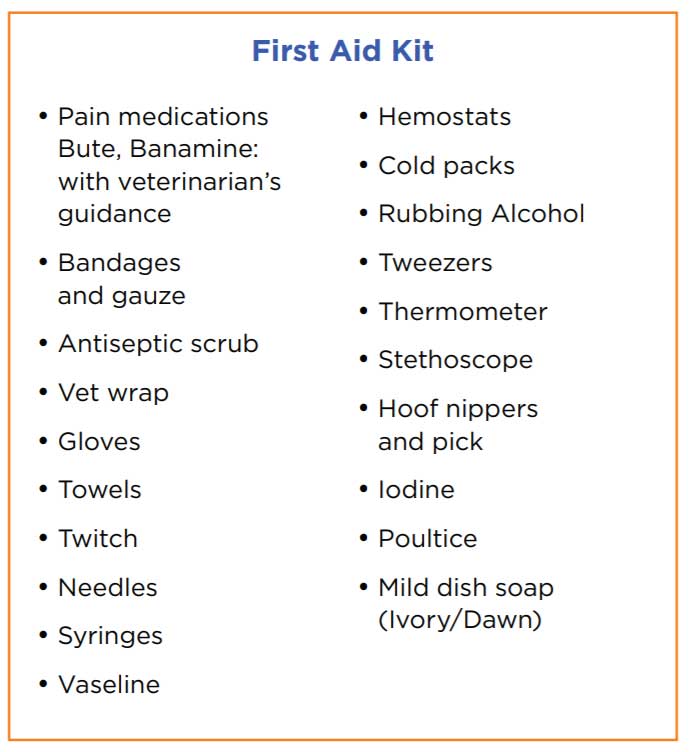
Euthanasia and Disposal Plan
Although end of life decisions are difcult for many equine owners, developing a plan ahead of time will help reduce emotional stress and grief. In the unfortunate situation that an animal dies due to natural disaster, options to consider include burial, composting, donations, incineration, cremation and landfll depending on location and disaster impact. For complete details please see the UT Extension publication by Forbes Walker, “Disposing of Large Animal Mortalities in Tennessee.” While not an option in Tennessee, some states may utilize rendering options also. Developing a plan first will also help prepare for financial costs of disposing the animal, which can range on average from $200 to $1,000 or more.
What to Do During a Natural Disaster
Please follow any mandatory evacuations or warnings for your area, as human life is the frst priority. Horses and other equids may be frightened and display aggressive tendencies during disaster. If unable to evacuate, use the following tips during emergencies/disasters.
Common to most kinds of disasters, keeping horses in pasture and not locked up in a barn is often safer and can help increase survival due the ability to get away from the natural disaster. For example, horses would be able to find higher ground during flooding, be able to escape from the direct line of tornadoes, and be free from a building that may collapse during hurricanes or wildfires. However, be mindful of the pastures that you keep your horses in. Avoid turning out into pastures that have power lines running through or across them due to the potential for downed lines and electrocution. Furthermore, good, safe, visible fencing is critical to prevent escapes, as well as prevent damage to both the horse and the fence.
Wildfires
In areas prone to wildfires, create a defensible space surrounding your house, barn and pastures. Defensible space has no grass, brush, chemicals or other items that can be ignited easily. It is recommended that a defensible space be a minimum of 100 feet around structures to be defended. If it is safe for you to do so, please consider wetting this area thoroughly. If embers drift onto your property, use gardening tools or other tools with a metal end to extinguish embers and decrease the chance of the fres spreading. Keep an eye on driveway conditions to ensure safe exit from your property. Get out before roads become treacherous or blocked.
Mark your property at the entrance with your contact information as well as the number and type of animals at your location for frefghters. While keeping your horses out in pasture is the safest option, in some cases, it may be safer for horses to run loose so they can escape from the fre. Make sure to close of all barns as horses may try to seek shelter when scared. Use leather or cotton halters as nylon halters may melt, even from a distance.
Know the signs of smoke inhalation in horses and seek veterinary intervention if present. If there is soot coming out of the horse’s nose or surrounding the eyes, then it is likely the horse has inhaled smoke. Burns should be treated by a veterinarian as soon as possible to prevent infection.
Flooding and Hurricanes
During times of fooding and hurricanes, higher ground within the pasture is the often the safest way to avoid foodwaters. However, if the barn is located at a higher elevation than pasture, it may be benefcial to house horses inside. Keep an eye on driveway conditions to ensure safe passage from your property, and get out before roads become treacherous or fooded. Use sandbags to create barriers around your barn or home. Try to keep hay and feed stored in high places to prevent spoiling. If possible, secure farm tools and other equipment. In times of high wind, keep fy masks on to prevent any eye injuries from fying debris. If horses are trapped in deep water and are unable to be rescued for several days, you can use a fotation raft to provide feed.
Tornadoes and Earthquakes
If you are in an area prone to tornadoes, it is best to keep your farm clear of random debris around both the barn and pastures. If possible, secure farm tools and other equipment. During tornadoes, if horses are not in pasture and are in the barn, please do not risk your safety to let them out. Keep fly masks on horses in order to prevent eye injuries from flying debris while out in pasture.
Like tornadoes, if an earthquake was to occur, do not risk your safety to let horses out of the barn during the earthquake. If you are inside your house when the earthquake happens, stay inside and find a safe space. Designate a safe space in or around the barn and home to seek shelter. Be prepared for aftershocks and take shelter as needed.

After the Disaster Has Passed
If you have evacuated, please pay attention to local area notices to determine when it is safe to return to your home or farm. Do not risk personal safety when coming back to check on animals.
- For those who evacuate with animals, it is best to check your property first for debris, foreign objects, downed power lines, and fences before bringing your animals back home.
- Keep horses out of flooded areas until floodwaters have receded. Floodwater may be contaminated with toxins, so it is best to provide a clean water source. Furthermore, it is best to keep horses of flooded pastures for at least two to three weeks after the floodwaters recede to prevent any potential toxins from being ingested while grazing. Flooded hay should be thrown out due to potential contamination. Lastly, mow pastures down to approximately 3 inches to allow for regrowth.
- Seek help from your veterinarian if any injuries or illness appear such as signifcant lameness or swelling, eye injuries, nasal discharge, cough, horses are of feed, lethargic, or have an elevated temperature.
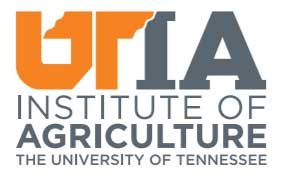
Take-Home Points
When preparing for natural disasters or other emergencies, it is helpful to know potential property risks, evacuation locations, and emergency contact information. It is also important to make sure horses have identification, either permanent or temporary. Having an updated plan of action is beneficial in reducing stress and increasing response efficiency when emergency situations arise. Make sure to regularly check your truck and trailer and that your horse is trained to load. Please make it a priority to keep yourself and your family safe. If you have any questions or would like further information, contact your county Extension office, equine Extension specialist, or visit UTHorse.com.
This article originally appeared on University of Tennessee Extension, Institute of Agriculture and is published here with permission.
Download a PDF of this article - click here..
Find other informative articles in our section on Health & Education.
References
(HSUS), T. H. (2011, March 16). Emergency Preparedness - Disaster Planning for Livestock . Retrieved from The University of Vermont: http://www.uvm.edu/~ascibios/?Page=Emergency/
Disaster_Planning_for_Livestock. html&SM=submenuemergency.html Allen Financial Group. (n.d.). Horse Trailer Safety Checklist. Retrieved from The Equestrian Group: https://www.eqgroup.com/Pdf/Horse%20Trailer%20 Checklist.pdf
AVMA. (n.d.). Large Animals and Livestock in Disasters. Retrieved from AVMA Website: https://www. avma.org/public/EmergencyCare/Pages/Large-Animals-and-Livestock-in-Disasters.aspx Cotton, S., & Mcbride, T. (2010, December). Caring for Livestock After Disaster. Retrieved from CSU Extension: https://extension.colostate.edu/topic-areas/ agriculture/caring-for-livestock-after-disaster-1-816/
Cotton, S., & McBride, T. (2013, August). Caring for Livestock During Disaster. Retrieved from CSU Extension: https://extension.colostate.edu/topic-areas/agriculture/caring-for-livestock-during-disaster-1-815/
Double D Trailers. (n.d.). 8 Things to check on your Tow Vehicle for Horse Trailer Safety. Retrieved from Double D Trailers: https://www.doubledtrailers. com/8-things-to-check-on-your-tow-vehicle-forhorse-trailer-safety/
House, A., & Zimmel, D. (n.d.). Hurricane Preparation for Florida’s Horses. Retrieved from UF IFAS Blogs: http://blogs.ifas.uf.edu/news/fles/2017/09/Hurricane-Preparation-for-Florida.pdf
How to Prepare for an Earthquake. (n.d.). Retrieved from California Academy of Sciences: https://www. calacademy.org/explore-science/how-to-preparefor-an-earthquake
Huf, N. (2014, November 20). State Travel Requirements. Retrieved from The Horse: https:// thehorse.com/148556/state-travel-requirements/
Irvine, K. (2017, September 6). Preparing Striegal, N. (2014, March). Wildfre Preparedness Your Horses for Evacuation. Retrieved from for Horse Owners. Retrieved from CSU Extension: UF IFAS Blogs: http://blogs.ifas.uf.edu/ nassauco/2017/09/06/preparing-horses-evacuation/
Margentino, M., Malinowski, K., Williams, C., & Malone, S. (2007). Horse Trailer Maintenance and Trailering Safety. Retrieved from Rutgers: https://esc.rutgers.edu/fact_sheet/horse-trailermaintenance-and-trailering-safety-2/
Pearson, N. (2007, May). Horses and Floods. Retrieved from Agriculutre Victoria: http:// agriculture.vic.gov.au/agriculture/livestock/horses/ horses-and-foods
Raia, P. (2011, September 8). Wildfres: When Evacuation is Not an Option. Retrieved from The Horse.com: https://thehorse.com/119821/wildfreswhen-evacuation-is-not-an-option/
Raia, P. (2015, March 4). Preparedness is Key to Surviving Tornadoes with Horses. Retrieved from The Horse.com: https://thehorse.com/116017/ preparedness-is-key-to-surviving-tornadoes-withhorses/ https://extension.colostate.edu/topic-areas/ agriculture/wildfre-preparedness-for-horseowners-1-817/
The Horse. (2019, July 9). Hurricane Preparation Tips for Horse Owners. Retrieved from The Horse.com: https://thehorse.com/119357/hurricane-preparationtips-for-horse-owners/
Tidwell, E., & Walker, N. (2017, October). Recovery of Pastures After Floods. Retrieved from LSU Ag Center: https://www.lsuagcenter.com/~/media/ system/e/f/3/4/ef34bf0e72c58b1cd4f8dc417ea4e16/ pub%20-%20educated%20horseman%20-%20 management%20-%20recovery%20of%20 pastures%20after%20foods_fnalpdf.pdf
U.C. Davis Veterinary Medicine. (n.d.). Flooding and Equine Owners. Retrieved from School of Veterinary Medicine: https://ceh.vetmed.ucdavis.edu/sites/g/ fles/dgvnsk4536/fles/local_resources/pdfs/delta_ fair_equine_2.pdf























